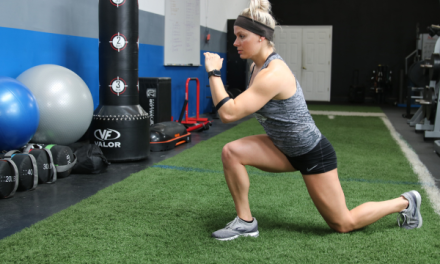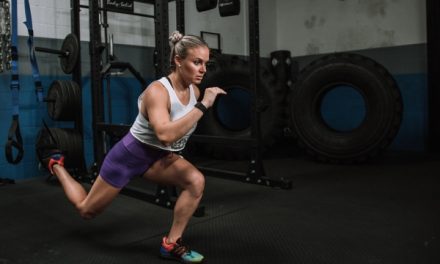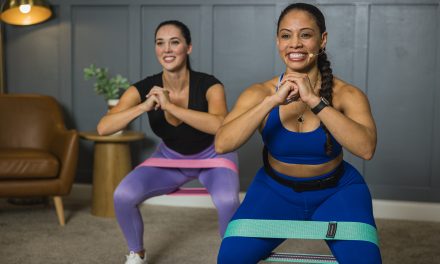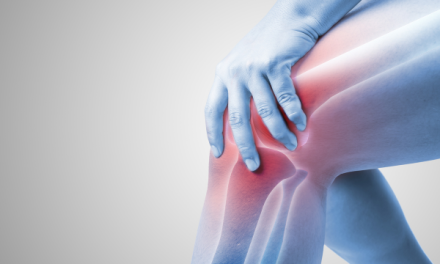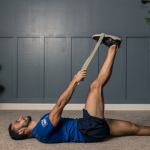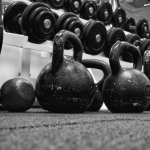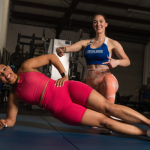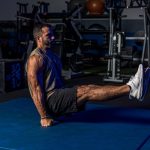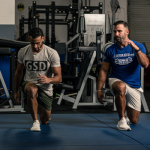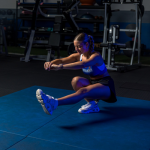A startling 80% of adults experience lower back pain at some point in their lives. [1]
And here’s the thing:
A significant portion of these cases could be mitigated or even prevented with proper physical conditioning and flexibility routines like dynamic stretching.
This form of active movement isn’t just a warm-up ritual… It’s an important part of maintaining overall mobility and health.
In this guide, we’ll cover everything you need to know about dynamic stretching including benefits, exercises, and tips to maximize your results.
Let’s get started with the basics:
What is Dynamic Stretching?
Dynamic stretching is just another way of saying active movements where joints and muscles go through a full range of motion.
These stretches are usually performed before a workout to prepare the body for vigorous activities.
Most importantly, dynamic stretching is characterized by controlled, smooth, and deliberate movements that typically mimic the sport or activity that will follow.
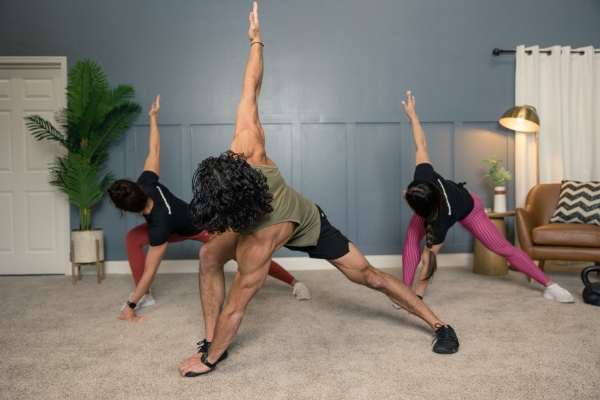
Dynamic vs. Static Stretching
Not all stretches are created equal.
Sure, static stretching plays an important role in your overall fitness but there are differences between static vs. dynamic stretching.
Static Stretching
Static stretching is probably what most people envision when they think of stretching.
It involves extending a muscle to its furthest point and then holding that position for a period of time, typically between 20 to 30 seconds.
This type of stretching is best performed after exercise when the muscles are warm and more elastic.
Its primary goal is to increase flexibility and cool the body down, making it an ideal practice for post-workout routines.
Benefits of Static Stretching
Here are the most notable benefits of static stretching:
Improves Flexibility: Regular static stretching can help improve your overall flexibility, which in turn enhances your physical performance and reduces the risk of injuries. [2]
Decreases Muscle Stiffness: This stretching method is effective in reducing muscle stiffness and soreness, which can help in recovery after a strenuous workout. [2] [3]
Improved Posture: Static stretching targets tight muscles that can cause slouching, such as the chest, shoulders, and hip flexors. By gently elongating these muscles, static stretching promotes proper spinal alignment and helps maintain an upright posture. [4]
When to Use Static Stretching
We recommend using static stretching to help muscles relax and to restore their length after contracting during a workout.
If you have a desk job or long periods of sitting, static stretches can help alleviate tension and maintain muscle health.
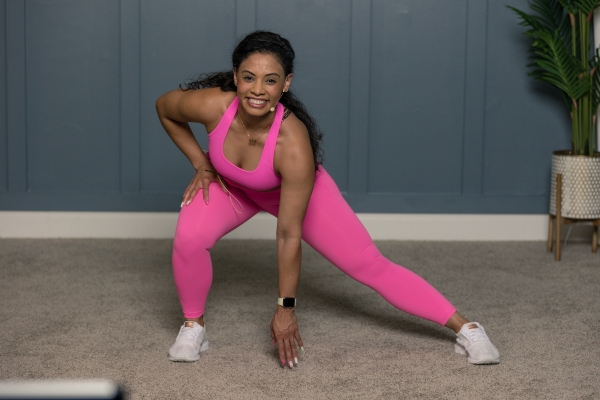
Dynamic Stretching
Unlike static stretching, dynamic stretching involves movement and muscular effort for the stretch to occur.
Instead of holding a single position, you perform movements that typically mimic the sport or activity you are about to engage in.
This prepares the body not only by warming up the muscles but also by activating the nervous system, coordination, and reflexes that are necessary for performance.
Benefits of Dynamic Stretching
Here are some of the benefits of dynamic stretching compared to static stretching:
Prepares the Body for Activity: Dynamic stretches improve core temperature, enhance blood flow, and prepare the muscles for the demands of the upcoming activity. [5]
Enhances Muscular Performance: By simulating actual movements of the sport or activity, dynamic stretching can help improve your muscular strength, agility, and speed. [5] [6]
Reduces Injury Risk: Properly preparing muscles and joints through dynamic stretching might reduce the risk of injuries during physical activity. [6] [7] [8]
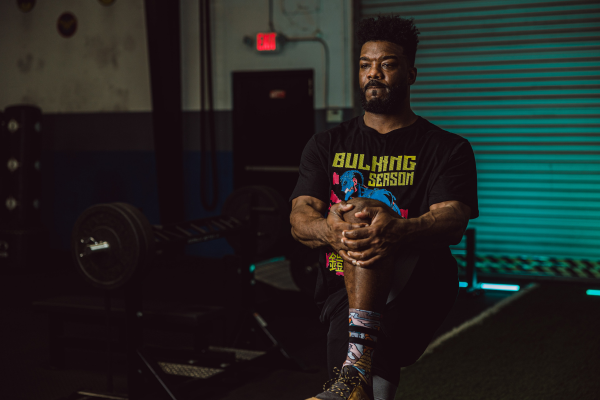
The Science of Dynamic Stretching
Dynamic stretching has garnered attention in sports science due to its effectiveness in preparing the body for physical activity.
This type of stretching involves movements that are specific to the motions of various sports or exercises, thereby not only warming up the muscles but also enhancing performance and reducing injury risks.
Joint Support
Dynamic stretching improves the elasticity of your muscles and increases the range of motion in your joints.
By actively moving your muscles through their full range of motion, dynamic stretching helps reduce muscle stiffness, which is often a precursor to injury.
What’s more, these movements help lubricate the joints, reducing the friction that can cause joint wear and tear over time. [5]
Increased Blood Flow
Dynamic stretches enhance blood circulation throughout the body.
This increase in blood flow raises muscle temperature, which enhances the elasticity of muscle fibers, making them less prone to tears.
It also helps improve the range of motion of the muscle. [5]
Enhanced Muscular Performance
Dynamic stretching primes the muscles for peak performance by activating them through sport-specific movements.
These dynamic motions enhance muscle activation and improve neuromuscular coordination, preparing your muscles to contract consistently and powerfully.
By stretching and contracting muscles through their full range of motion, they operate at an optimal length, boosting energy efficiency and ensuring sustained endurance during workouts.
The neural preparation from these stretches fine-tunes your body’s communication network, helping your muscles respond rapidly and accurately.
As the stretches mirror actual workout movements, they offer a sport-specific warm-up that directly translates to improved performance, whether for cardio, weightlifting, or competitive sports. [5] [6]
Injury Prevention
Dynamic stretching plays a critical role in preventing injuries by preparing the muscles and joints for the stresses of physical activities.
It helps by promoting better coordination and balance, which are essential for avoiding falls and missteps during high-intensity activities. [6] [7] [8]
Proprioception
Moreover, dynamic stretching increases proprioception – the awareness of body position and movement – which is crucial in complex movements seen in sports and fitness activities.
This heightened awareness can help athletes make quicker adjustments during physical activity, further reducing injury risk.
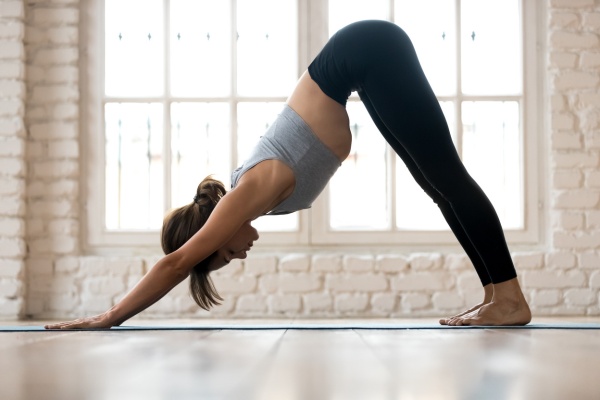
When to Use Dynamic Stretching
Dynamic stretching is a versatile part of physical fitness that can be tailored to suit a variety of scenarios, from sports to daily life.
Understanding when and how to use dynamic stretching can maximize its benefits, enhancing both performance and flexibility.
During Your Day-to-Day
You don’t have to be an athlete or involved in sports to enjoy the benefits of dynamic stretching.
Incorporating dynamic stretching into your daily routine can significantly improve your physical health and overall well-being.
For non-athletes, dynamic stretches can help maintain mobility, reduce muscle stiffness, and increase blood circulation, which is especially beneficial for those with sedentary lifestyles.
Morning Routine: Simple stretches such as arm circles, leg swings, or torso twists right after waking up can invigorate the body, help ease morning stiffness, and kickstart the metabolism.
Office Breaks: To counteract the effects of prolonged sitting, dynamic stretches such as chair squats or desk push-ups can be performed during short breaks to reduce the risk of postural issues and stimulate mental alertness.
Pre-Workout or Pre-Competition
Dynamic stretching is most beneficial when performed before any workout or sporting competition.
It prepares the body for physical exertion and helps prevent injuries by warming up the muscles, increasing heart rate, and promoting blood flow.
This type of stretching ensures that the muscles are more elastic and ready to perform, which is particularly crucial in high-intensity sports.
Example: Before a track and field sprint, athletes might perform leg swings, ankle bounces, and arm swings to mimic running motions and prepare their body for the explosive action required.
Specific Scenarios for Different Sports or Activities
Here are some specific fitness examples of when dynamic stretching would be extremely beneficial:
Running: Dynamic stretches like high knees, butt kicks, and side shuffles increase the core temperature and activate the muscles used during running, improving stride efficiency and reducing the risk of strains.
Swimming: Arm swings, shoulder circles, and hip rotations help loosen up the joints and muscles involved in swimming strokes, reducing the chances of shoulder and hip injuries.
Team Sports (e.g., Soccer, Basketball): Activities like dynamic lunges, twists, and jumping jacks are ideal as they prepare the body for the multidirectional movements and quick shifts in pace typical in these sports.
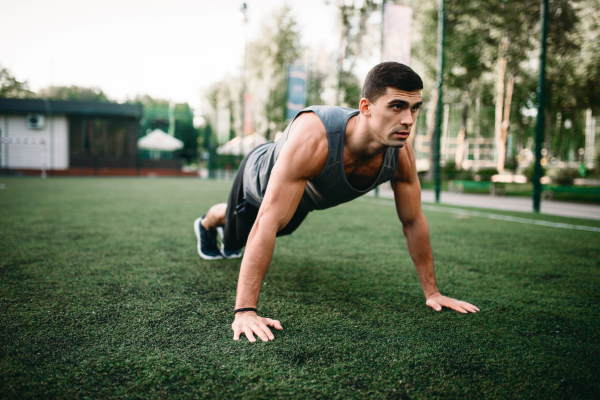
Essential Dynamic Stretches: Step-by-Step Guides
Here’s a breakdown of essential dynamic stretches for the lower body, upper body, and full body, complete with step-by-step instructions.
Lower Body Stretches
The following dynamic stretches focus on prepping the lower body:
Leg Swings (Front to Back, Side to Side)
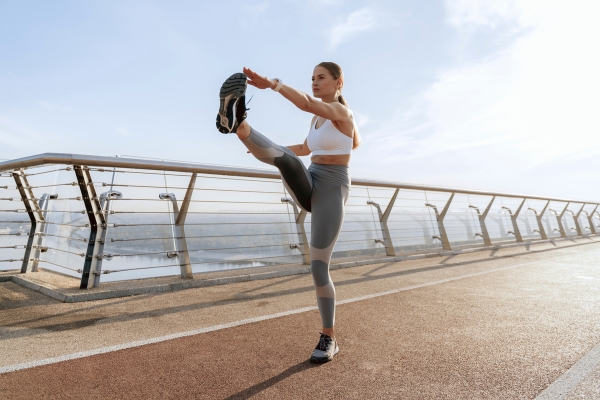
How to Do It:
- Stand next to a wall or hold onto a sturdy object for balance.
- Swing one leg forward and backward, gradually increasing the range of motion. Perform 10-15 swings.
- Switch to side-to-side swings by facing the wall, swinging your leg left to right across your body, also 10-15 times.
- Repeat with the other leg.
Walking Lunges
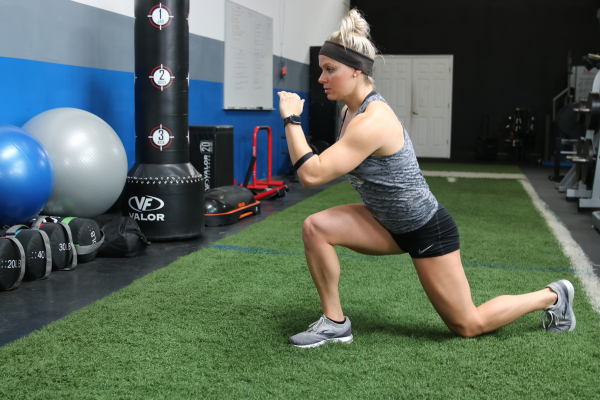
How to Do It:
- Stand with your feet together and take a step forward with one leg.
- Lower your hips so that both knees form approximately 90-degree angles. Ensure the back knee remains slightly elevated just above the ground.
- Ensure the front knee is directly above the ankle, not pushed out too far.
- Push off with your back foot and step forward, repeating the lunge on the other leg. Continue for 10-20 meters.
High Knees
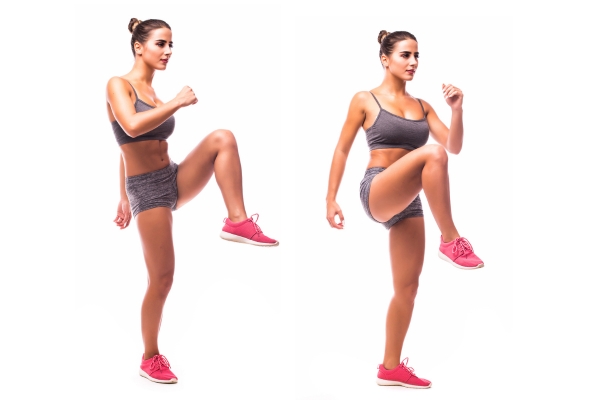
How to Do It:
- Stand with your feet hip-width apart.
- Jog in place while lifting your knees high towards your chest.
- Pump your arms to keep balance and increase intensity.
- Continue for 20-30 seconds.
Upper Body Stretches
Let’s move on to the upper body – Here are some of the best upper body dynamic stretches:
Arm Circles
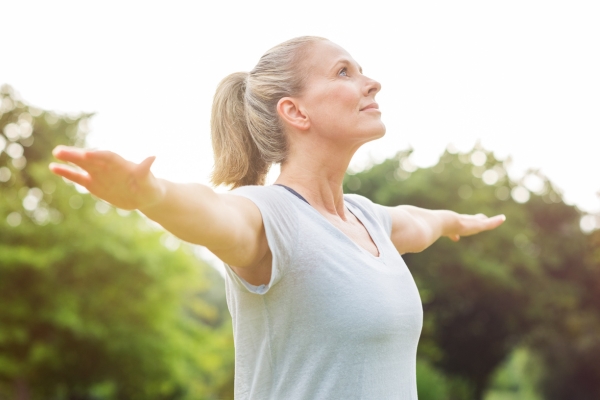
How to Do It:
- Stand with your feet shoulder-width apart and extend your arms parallel to the floor.
- Slowly make small circles with your arms, gradually increasing the size of the circles.
- Continue for about 10-15 seconds, then reverse the direction and repeat.
Torso Twists
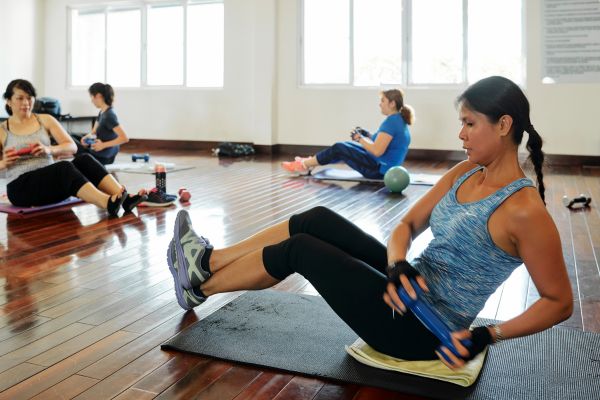
How to Do It:
- Position yourself with your feet shoulder-width apart and a slight bend in your knees.
- Stretch your arms out to the sides so they are level with your shoulders.
- Smoothly rotate your upper body to one side and then to the other, while keeping your hips steady and facing forward.
- Move in a fluid motion for 15-20 seconds.
Shoulder Shrugs

How to Do It:
- Stand with your feet hip-width apart.
- Raise both shoulders up towards your ears, then release them back down.
- Perform this in a smooth, controlled motion for 10-15 repetitions.
Full-Body Dynamic Stretches
Let’s wrap it up with full-body dynamic stretching exercises:
Inchworms
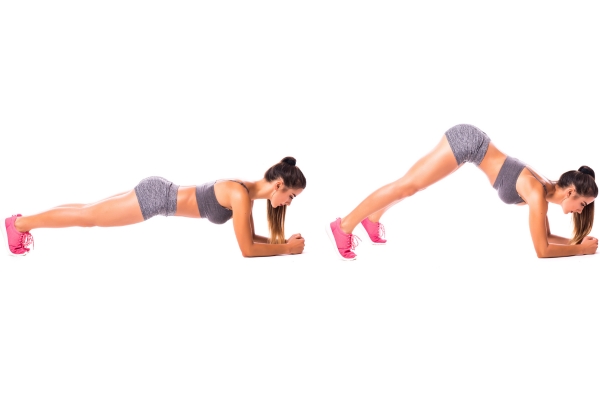
How to Do It:
- Stand with your feet hip-width apart.
- Lean forward from the waist and set your hands on the floor in front of you.
- Then, slowly walk your hands out until your body achieves a straight line, reaching a full plank position.
- Pause briefly, then walk your feet towards your hands in small steps.
- Stand up and repeat for 4-6 repetitions.
Dynamic Planks
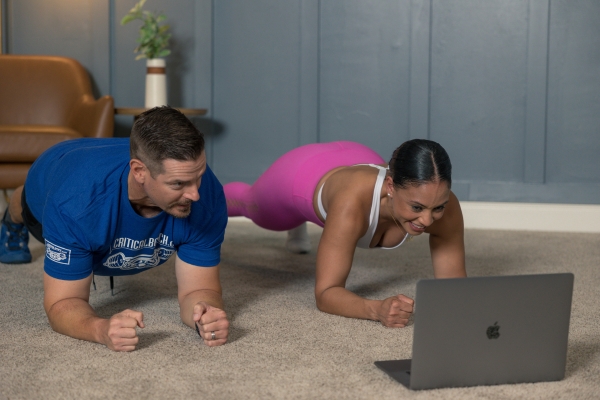
How to Do It:
- Start in a standard plank position with your forearms on the ground and your body in a straight line.
- Shift your weight to one arm and rotate your body to open up towards the side, extending your free arm towards the ceiling.
- Return to the plank position and repeat on the other side.
- Perform 8-10 rotations per side.

Best Practices for Dynamic Stretching
Dynamic stretching can significantly improve your flexibility, mobility, and overall athletic performance when done correctly.
To ensure you’re maximizing the benefits of your dynamic stretching routine, here are some best practices to follow:
Warm-Up Tips to Maximize Effectiveness
Begin with gentle movements to slowly increase your heart rate and blood flow to muscles.
This gradual approach helps to prevent injuries and prepares your body for more intense stretching.
Increase the intensity and range of motion as your body warms up.
Start with smaller movements and gradually move to larger ranges to effectively prepare the muscles and joints for activity.
To engage all the major muscle groups, include stretches that involve different parts of the body.
This holistic approach ensures a balanced warm-up, reducing the likelihood of overlooking any important muscle group.
How Long to Stretch and How Many Repetitions
Each dynamic stretching routine should last about 5 to 10 minutes, depending on the intensity of the activity that will follow.
This duration is typically sufficient to raise muscle temperature and enhance muscle function.
Perform each stretch for about 10-15 repetitions per side.
This amount ensures that the muscles are adequately stimulated without causing fatigue before your main activity.
Include dynamic stretching in your warm-up routine every time you prepare for physical activity, especially before workouts involving high levels of mobility and endurance.
Common Mistakes to Avoid
Avoid starting with high-intensity stretches without a proper initial warm-up.
Jumping into intense movements abruptly can lead to muscle strains or other injuries.
Dynamic stretching is about movement, not holding positions.
Do not confuse it with static stretching, where stretches are held for a longer duration.
Keeping dynamic stretches fluid and moving is key.
Remember that proper breathing is crucial during stretching.
Inhale and exhale smoothly to ensure the muscles receive the oxygen they need to function optimally.
Avoid holding your breath, which can increase blood pressure and tension within the muscles.
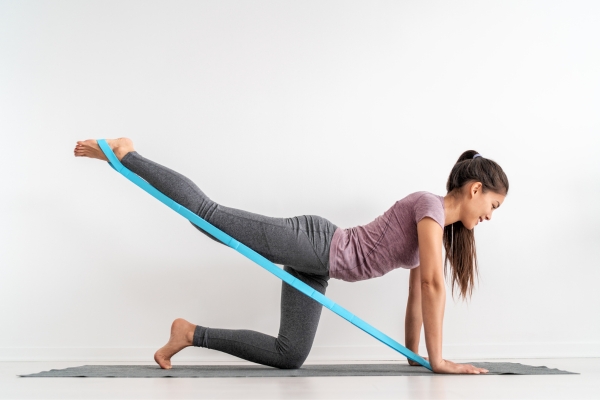
Advanced Dynamic Stretching Techniques
For those looking to take their dynamic stretching routine to the next level, incorporating advanced techniques can provide additional benefits like increased resistance, improved muscle activation, and enhanced coordination.
Here are three advanced techniques to enrich your dynamic stretching routine:
Incorporating Resistance Bands
Incorporating resistance bands into dynamic stretching adds resistance to the movements, which increases muscle activation during each stretch.
This not only helps improve both flexibility and strength simultaneously but also provides valuable feedback on the intensity and form of each stretch, allowing for adjustments to be made in real-time for optimal performance.
Here are some of the best ways to incorporate resistance bands into your dynamic stretching workout:
Leg Swings with Resistance Bands
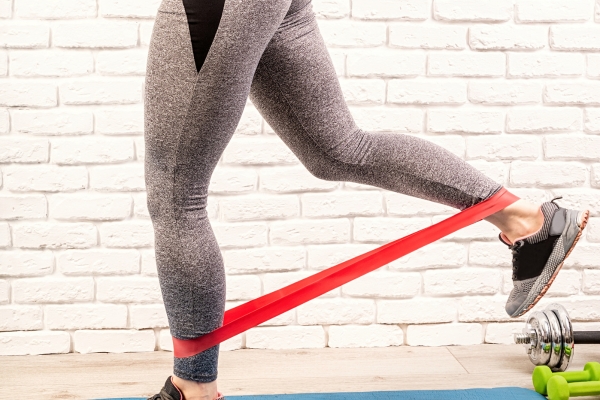
How to Do It:
- Use a looped resistance band or tie a longer band into a loop. Place the loop around both your legs, securing it just above your knees.
- Stand with your feet hip-width apart, holding onto a wall, chair, or sturdy surface for balance.
- Shift your weight onto your left leg and lift your right foot off the ground.
- Swing your right leg forward against the resistance of the band, then swing it backward.
- Keep the swinging movement controlled and your standing leg stable.
Banded Arm Circles
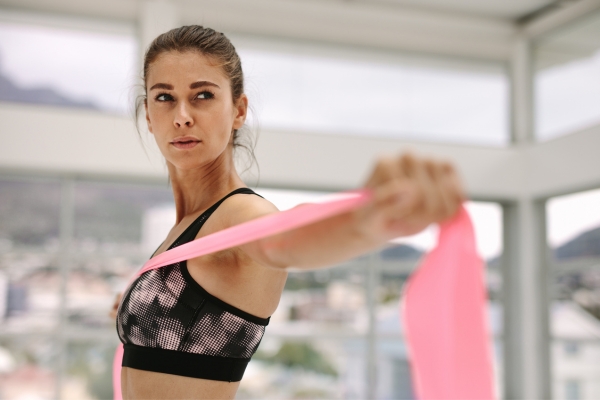
How to Do It:
- Hold a resistance band with both hands and stretch it out in front of you.
- Keep your arms straight and your core engaged.
- With your arms extended, start making small circles, gradually increasing the size of each circle.
- After completing 10-15 circles in one direction, reverse the direction and do the same number of circles.
Plyometrics Involving Dynamic Stretches
Plyometrics involving dynamic stretches integrate explosive movements with traditional stretching techniques.
This combination not only increases power and speed, which are crucial for many sports, but also enhances neuromuscular adaptation and improves reaction time.
Such dynamic and explosive exercises help athletes achieve greater athletic performance by conditioning the body to respond more effectively during sports activities.
Here’s how to combine dynamic stretching with plyometrics:
Jump Squats
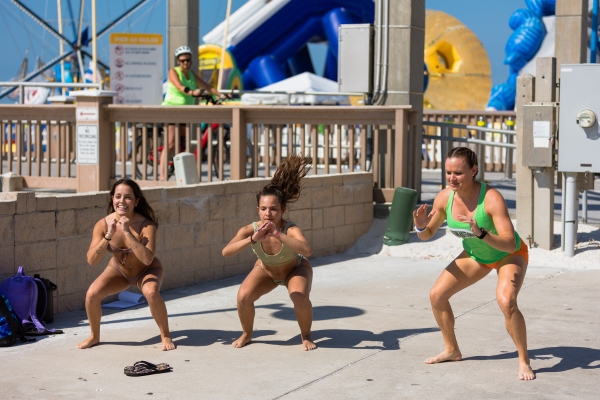
How to Do It:
- Stand with feet shoulder-width apart, toes pointing forward, and your hands at your sides.
- Lower into a standard squat position by bending at the knees and hips while keeping your chest lifted and your back straight. Aim for thighs to be parallel to the ground.
- Press through your heels to explosively jump up off the ground, fully extending your legs.
- Land softly on the balls of your feet, immediately bending your knees and hips to absorb the impact and return to the squat position.
- Perform the movement continuously, maintaining good form throughout. Aim for a controlled and fluid motion.
Skater Hops
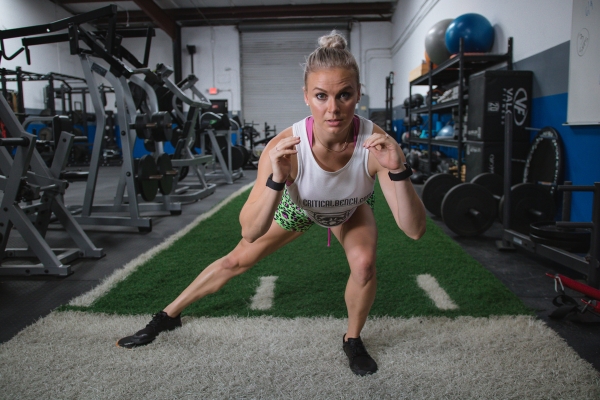
How to Do It:
- Stand with your feet shoulder-width apart and slightly bend your knees. Lean your torso forward slightly, keeping your back straight.
- Push off with your right leg to leap to the left, landing on your left foot while swinging your right leg behind your left. Use your arms for balance by swinging your left arm forward and your right arm backward.
- Immediately push off with your left foot to leap to the right, landing on your right foot while swinging your left leg behind your right. This time, swing your right arm forward and your left arm backward for balance.
- Continue alternating sides in a controlled manner. Focus on increasing speed and distance while maintaining good balance and a steady rhythm.
Partner Stretching Exercises
Partner stretching exercises enable the performance of stretches that might be challenging to execute alone.
Having a partner can provide additional resistance or support, thereby enhancing the effectiveness of the stretch.
Moreover, working with a partner increases both motivation and accountability, making it more likely that you will engage regularly and effectively in your stretching routine.
Partner Assisted Hamstring Stretch
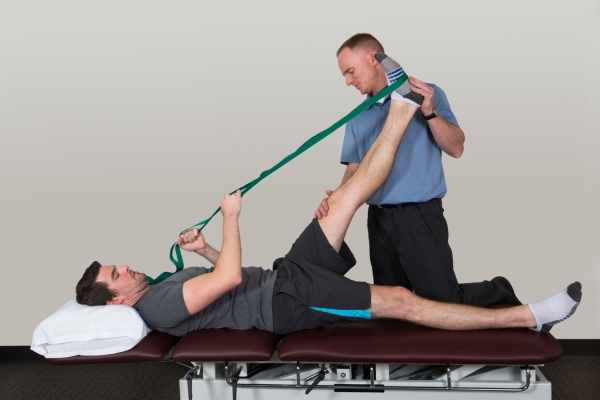
How to Do It:
- Lie flat on your back with one leg extended straight on the ground and the other raised, keeping the knee straight. Your partner should kneel beside you, facing the raised leg.
- Have your partner gently hold your raised leg by the ankle and heel to stabilize it.
- Keep your raised leg as straight as possible while your partner slowly pushes it toward your chest.
- As your partner gently pushes the leg, keep your lower back flat on the ground to maintain the stretch.
- Once you feel the stretch in your hamstrings, your partner can push the leg back down slightly before repeating the stretch in a controlled motion.
- Perform a few repetitions, then switch legs.
Dynamic Chest Stretch
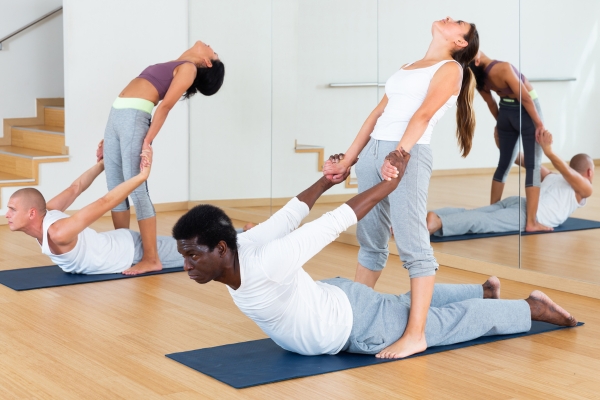
How to Do It:
- Person 1 should lie flat on their back with arms extended behind their head, resting on the ground.
- Person 2 should stand at the head of the Person 1 lying down and grasp their wrists or forearms firmly, ensuring a secure grip.
- Person 2 should slowly lean back, gently pulling Person 1’s arms upward and away from the ground. This motion creates a dynamic stretch for Person 1’s chest, shoulders, and upper back.
- Simultaneously, as you lean back, you’ll feel a stretch across your own chest, shoulders, and arms.
- Hold the stretch for 1-2 seconds, then release slightly to relax the tension.
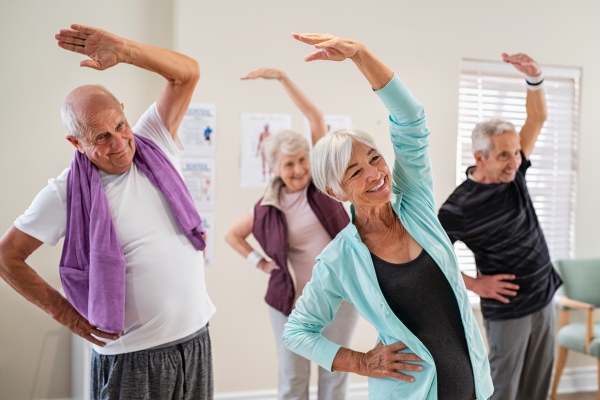
The Role of Dynamic Stretching in Different Age Groups and Fitness Levels
Dynamic stretching is a tool that can be adapted to benefit individuals of all ages and fitness levels.
By tailoring dynamic stretches to specific needs, everyone from children to older adults, and from beginners to experienced athletes, can enhance their mobility, flexibility, and overall physical health.
Children
Dynamic stretches for children should focus on promoting fun and engagement while incorporating basic movements that enhance coordination and motor skills.
Examples include animal walks (like bear crawls or frog jumps) and playful activities that mimic sports movements in a non-competitive way.
It’s important to ensure that stretches are age-appropriate and not too rigorous, to avoid putting undue stress on developing joints and muscles.
Older Adults
For older adults, dynamic stretches should emphasize maintaining mobility and preventing stiffness.
Gentle movements that don’t strain the joints are ideal, such as arm swings, leg lifts, and walking lunges with support if necessary.
Focus on stretches that improve balance and functional movements, which are crucial for daily activities and reducing fall risk.
Beginners
Beginners should start with simple and less intense dynamic stretches to gradually build their flexibility and familiarity with the movements.
Fundamental exercises like arm circles, hip rotations, and easy walking lunges provide a solid foundation without overwhelming new starters.
Emphasis should be placed on learning proper form and technique to build a safe practice, possibly under the guidance of a fitness professional.
Experienced Athletes
Experienced athletes can incorporate more complex and sport-specific dynamic stretches that simulate the movements of their respective sports or activities.
These might include high-intensity drills like high knees, tuck jumps, or sport-specific agility drills.
Athletes should focus on using dynamic stretching to enhance performance and reduce the risk of sports-related injuries by targeting the specific muscle groups most used in their sports.
Tailoring Dynamic Stretches
Dynamic stretching should be tailored to the individual’s current fitness level and mobility.
This personalization helps address specific areas of concern, such as limited range of motion in certain joints or previous injuries.
Modifications can be made to standard stretches to accommodate mobility issues.
For example, a person with limited knee flexibility might perform modified high knees or use support for walking lunges.
It’s essential to continuously assess and adjust the intensity and type of stretches based on personal progress and any new health considerations.
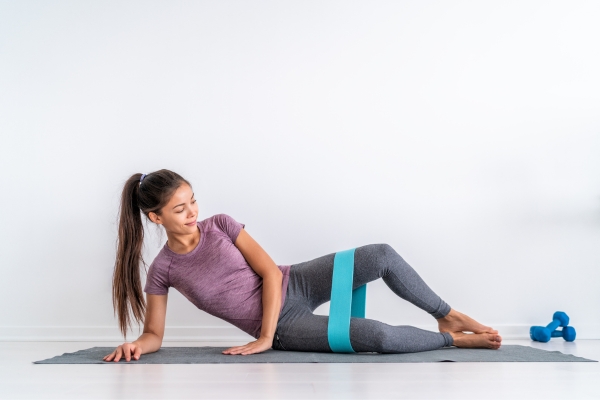
Wrap-Up and Key Points
Dynamic stretching is a powerful tool that can significantly enhance your physical health, whether you’re an athlete warming up for a competition or someone simply looking to maintain mobility and reduce pain in daily life.
By incorporating dynamic stretches into your routine, you prepare your body not only for immediate physical exertions but also for long-term health and performance.
Embracing the adaptability of dynamic stretching to suit various age groups, fitness levels, and specific needs ensures that everyone can benefit from these movements.
Remember, the key is consistency and proper execution to make the most of dynamic stretching.
Key Points to Remember
- Versatility of Dynamic Stretching: Suitable for all ages and fitness levels, dynamic stretches can be modified to meet individual needs and conditions.
- Preparation for Physical Activities: Dynamic stretching effectively prepares the body for physical activity, reducing the risk of injuries and enhancing performance.
- Benefits Across Age Groups: From improving children’s motor skills to maintaining mobility in older adults, dynamic stretching serves diverse purposes.
- Enhanced Athletic Performance: For athletes, dynamic stretching is crucial for optimizing performance and minimizing sports-related injuries.
- Incorporate Regularly: Making dynamic stretching a regular part of your fitness routine can lead to significant improvements in flexibility, strength, and overall well-being.
FAQ: Dynamic Stretching
Why is Dynamic Stretching Important Before Exercise?
Dynamic stretching is crucial before exercise because it warms up the body, increases blood flow, and prepares the muscles and joints for the movements they will perform during the workout.
This type of stretching helps elevate the heart rate and body temperature, which can improve muscle elasticity and reduce the risk of injuries. It also activates the nervous system, which can enhance muscular performance and efficiency during the subsequent exercise.
Can Dynamic Stretching Improve Performance?
Yes, dynamic stretching can improve performance.
Studies have shown that dynamic stretching can increase muscle temperature and flexibility, which are linked to better muscular strength, agility, and overall performance.
By mimicking the movements of the activity or sport that follows, dynamic stretching also helps improve neuromuscular coordination, making the body more efficient at those movements.
This can lead to improvements in speed, power, and endurance, especially important in competitive sports settings.
What Are the Best Dynamic Stretches for Runners?
For runners, dynamic stretches that mimic running movements are particularly beneficial. Some of the best dynamic stretches for runners include:
- Leg Swings: Help loosen the hip flexors and hamstrings, which are heavily used during running.
- High Knees: Promote increased range of motion and temperature in the hips and knees.
- Butt Kicks: Focus on the hamstrings, improving the knee's flexion during running.
- Walking Lunges: Activate the hip flexors and stretch the leg muscles dynamically, preparing them for the impact of running.
How Often Should You Do Dynamic Stretching?
Dynamic stretching is best performed before each workout to maximize the body's readiness for physical activity.
For those who engage in regular physical activities or sports, incorporating dynamic stretching into every warm-up session is recommended.
However, it can also be useful when integrated into a daily routine, especially for those with sedentary lifestyles, to maintain flexibility and muscle function.
Is Dynamic Stretching Good for All Ages?
Yes, dynamic stretching is beneficial for people of all ages.
For children, it can help develop motor skills, coordination, and body awareness.
In adults, it enhances flexibility, strength, and cardiovascular health.
Older adults can also benefit from dynamic stretching as it helps maintain muscle elasticity, joint health, and mobility.
However, the intensity and types of dynamic stretches should be adjusted according to age and physical condition to ensure safety and effectiveness.
What Are Some Common Mistakes in Dynamic Stretching?
Common mistakes in dynamic stretching include:
- Not warming up sufficiently before starting: Dynamic stretches are most effective when the muscles are slightly warm. Jumping into dynamic stretches without a basic warm-up can lead to muscle strains.
- Using improper form: Incorrect technique can reduce the effectiveness of the stretch and increase the risk of injury.
- Stretching too aggressively: Too vigorous or fast movements can overextend the muscles and lead to injuries.
- Neglecting breathing: Proper breathing is essential during dynamic stretching to ensure that the muscles receive enough oxygen.
How Long Should a Dynamic Stretching Routine Last?
A dynamic stretching routine should last between 5 to 15 minutes, depending on the intensity of the activity that follows.
This duration is enough to increase body temperature, enhance muscle function, and improve range of motion without causing fatigue. It’s important to cover all major muscle groups and to focus on movements that relate closely to the activities planned for the session.
Can Dynamic Stretching Replace a Traditional Warm-Up?
Dynamic stretching can be a crucial part of a traditional warm-up, but it should not replace the entire warm-up routine, especially for high-intensity activities.
A comprehensive warm-up usually includes a general cardiovascular component, such as light jogging or cycling, to raise overall body temperature, followed by dynamic stretching to specifically prepare the muscles and joints. This combination ensures the body is fully prepared for physical exertion.
What Dynamic Stretches Can Help with Lower Back Pain?
Dynamic stretches that can help alleviate and prevent lower back pain include:
- Cat-Cow Stretches: This yoga movement increases flexibility in the spine and relieves tension in the torso and neck.
- Hip Circles: Rotating the hips helps loosen the lower back and hip muscles.
- Pelvic Tilts: These can strengthen abdominal muscles, which support the back, and reduce stress on the lower spine.
- Walking Lunges: This stretch helps improve flexibility in the hip flexors, which can reduce the strain on the lower back.
References
Archives of Internal Medicine
Freburger JK, Holmes GM, Agans RP, Jackman AM, Darter JD, Wallace AS, Castel LD, Kalsbeek WD, Carey TS. The rising prevalence of chronic low back pain. Arch Intern Med. 2009 Feb 9;169(3):251-8. doi: 10.1001/archinternmed.2008.543. PMID: 19204216; PMCID: PMC4339077.
Journal of Functional Morphology and Kinesiology
Bryant J, Cooper DJ, Peters DM, Cook MD. The Effects of Static Stretching Intensity on Range of Motion and Strength: A Systematic Review. Journal of Functional Morphology and Kinesiology. 2023; 8(2):37. https://doi.org/10.3390/jfmk8020037
International Journal of Exercise Science
Brodeur ZR, Paustian MJ, Monteleone-Haught DA, Lamm RA, Pagano AG, Ellis CE. The Effects of Static and Dynamic Stretching on Muscle Oxygen Saturation in the Rectus Femoris. Int J Exerc Sci. 2022 May 1;15(3):702-708. PMID: 35991352; PMCID: PMC9365106.
Journal of Motor Behavior
Oba K, Ohta M, Mani H, Suzuki T, Ogasawara K, Samukawa M. The Effects of Static Stretching On Dynamic Postural Control During Maximum Forward Leaning Task. J Mot Behav. 2023;55(6):594-602. doi: 10.1080/00222895.2021.1909529. Epub 2021 Jun 21. PMID: 34148509.
Journal of Sports Science and Medicine
Iwata M, Yamamoto A, Matsuo S, Hatano G, Miyazaki M, Fukaya T, Fujiwara M, Asai Y, Suzuki S. Dynamic Stretching Has Sustained Effects on Range of Motion and Passive Stiffness of the Hamstring Muscles. J Sports Sci Med. 2019 Feb 11;18(1):13-20. PMID: 30787647; PMCID: PMC6370952.
Sports Medicine
Opplert J, Babault N. Acute Effects of Dynamic Stretching on Muscle Flexibility and Performance: An Analysis of the Current Literature. Sports Med. 2018 Feb;48(2):299-325. doi: 10.1007/s40279-017-0797-9. PMID: 29063454.
International Journal of Sports Physical Therapy
Page P. Current concepts in muscle stretching for exercise and rehabilitation. Int J Sports Phys Ther. 2012 Feb;7(1):109-19. PMID: 22319684; PMCID: PMC3273886.
Sports Medicine
Behm DG, Alizadeh S, Daneshjoo A, Konrad A. Potential Effects of Dynamic Stretching on Injury Incidence of Athletes: A Narrative Review of Risk Factors. Sports Med. 2023 Jul;53(7):1359-1373. doi: 10.1007/s40279-023-01847-8. Epub 2023 May 10. PMID: 37162736; PMCID: PMC10289929.

